Patient Navigator Facilitated Text Messaging Intervention Improves Linkage to care in Viral Hepatitis B: A Pilot Study
Patient Navigator Facilitated Text Messaging Intervention Improves Linkage to care in Viral Hepatitis B: A Pilot Study
Chul S. Hyun, MD, PhD1, Soyoung Yoon, BSN2, Soonsik Kim, MPH2, Seulgi Lee, BS1, Joseph McMenamin, MD, JD3
1Center for Viral Hepatitis, United States; 2Korea Community Health Services, United States; 3W Medical Strategy Group, United States
Corresponding Author: chulhyunmd@gmail.com
Journal MTM 6:2:11–18, 2017
Background: Despite the high prevalence of chronic hepatitis B (CHB) in Asian Americans and other ethnic groups, a majority of these populations remains unscreened and unprotected. A large percentage of those who are chronically infected with hepatitis B virus (HBV) are not linked to care owing to a poor health care access. The purpose of this study was to evaluate the use of mobile text messaging in engaging individuals with hepatitis B or at risk for it, and to assess their acceptance of text messaging interventions.
Materials and Methods: A total of 32 individuals who were either chronically infected with HBV or non-immune to HBV were assigned to a patient navigator (PN), who subsequently arranged for the subjects to communicate through text messaging. The frequency and contents of messages between the subjects and the PN were evaluated. After the three month intervention period, results on linkage to care (LTC) were obtained. A self-report questionnaire was employed to assess the subjects’ feedback on the use of text messaging.
Results: All of 32 participants responded to the PNs with either text messaging or phone calls. The most frequent message themes were finding doctors and appointment reminders. Fourteen of 16 HBV infected subjects were linked to physicians, and all of 16 non-immune subjects received one or two vaccinations. The survey revealed strong receptivity to and acceptance of the use of text messaging.
Conclusions: Mobile text messaging intervention provides a platform for patients to engage with medical personnel, thereby improving their access to healthcare.
Background
Chronic hepatitis B (CHB) is a major cause of chronic liver diseases, affecting 350 million people around the world.1,2 In the United States alone, 3–10% of Asian Americans have Hepatitis B virus (HBV) infections. Studies have shown that fewer than 25% of Asian Americans infected with HBV have been diagnosed, suggesting that a large population may serve as a reservoir for transmission. Furthermore, fewer than 10 percent of the patients who may need treatment are currently receiving antiviral medication.3,4,5
Many barriers hinder access to CHB care in the Asian American community and in other ethnic minority populations. While financial problems are crucial, lack of health literacy associated with poor patient- physician communication are also formidable barriers affecting LTC in these minority populations.6,7,8,9 Improvements in patient education, counseling, and navigation may create an effective strategy to improve linkage from diagnosis to HBV-directed care.
Any effective patient-oriented communication tool that can provide linguistically and culturally accessible information necessary for health maintenance has potential to foster patients’ engagement in their care. mHealth tools as simple as smartphones may be good examples and have been utilized to increase access to healthcare. Smartphones can not only facilitate communication between patients and their physicians, but can also create new ways to provide patients with disease education, and connect them to a variety of resources in their communities.10,11,12 Smartphones and other mHealth tools also offer a unique advantage in that they can provide easy, anonymous, and comparatively inexpensive access to people irrespective of their cultures, languages, incomes, or geographical locations.
Certain ethnic minority groups are more likely to own mobile phones and to use them to access specific health information that would not otherwise be readily available to them, thereby tending to reduce health disparities. A recent Pew Internet Research Center survey, for instance, showed that English-speaking Asian Americans had a higher level of ownership of smartphones than any other ethnic group in the U.S.13,14,15 A striking 98% of Asian Americans own some type of cell phone, compared with 90% of whites, 92% of blacks and 93% of Hispanics.
Seventy-five percent of the 4.5 billion cellular phone users worldwide currently use text messaging, and 97% of Americans use it at least once per day.16 Thus, for Asian Americans and other minority ethnic groups, text messaging can provide patients with information on health care in their own languages, and can promote health literacy and preventive medicine, thereby combating the health disparities related to CHB care. Health-related text messaging via mobile phones started with routine appointment reminders.17,18 Text messaging has subsequently been tested as a tool to engage patients with a variety of medical conditions. Motivational text messages to young children with type 1 diabetes mellitus have demonstrated positive effects on diabetes control and adherence.19 Tailored text messaging has also been shown to have a positive impact on behavior changes in diabetic adults.20
Text messaging has also been shown to improve treatment adherence and health outcomes in HIV patients.21,22,23 Other examples include Text4Health-Adolescents, a randomized text messaging intervention, which facilitated improved immunization rates in a low-income, urban population.24 Similarly, the Text4Baby campaign helped expectant mothers to receive prenatal information and other important resources.25 In addition, text messaging has been successfully implemented in smoking cessation,26 weight control,27 and treatment of tuberculosis.28
In this study, we investigated the use of text messaging in facilitating the connection between subjects and physicians. We also examined subjects’ responses to the potential benefits of text messaging in health maintenance. The results suggest that in an ethnic minority population text messaging can effectively link patients to hepatitis care.
Methods
Participants
A group of 32 Korean Americans aged 18 to 69 was randomly selected from persons enrolled in a community-based hepatitis B screening campaign conducted in metropolitan New York between January 2015 and June 2015. All the participants were Korea-born immigrants, and preferred to communicate in Korean. They owned either smartphones or other cell phones with text messaging capability. A total of 16 individuals chronically infected with HBV, who were found to be hepatitis B surface antigen positive, was identified (CHB group). Another group of 16 people, who demonstrated a lack of immunity, was also identified (non-immune group). Both CHB and non-immune groups were assigned to a PN, who then initiated communication procedures. Hepatitis B screening results were initially provided by the PN to all the participants in person or by phone. This was immediately followed by a text message to each participant. Through text messaging, the non-immune group was sent initial messages advising them to receive free hepatitis B vaccination at one of the local health care facilities. The CHB group was also advised to see a physician for further evaluation and management. The members were asked to contact the PN with any questions. All communications between the participants and the PN took place during the three month period September 1, 2015 to November 30, 2015. At the end of the three months, the PN called and/or texted each participant to determine the presence or absence of linkage.
Patient Navigators
The PN program provided all participants with specific information they needed to be adequately linked to a physician or a health care facility. The study employed two PNs. One had a Masters in public health and the other had a BS in nursing. Both PNs were employees of a non-profit community service organization. PNs were bilingual members of the subjects’ community who were familiar with clinicians and other health care resources within that community. PNs also had experience in advising CHB patients and were supervised by a group of gastroenterologists.
For further evaluation of CHB in this study, all 16 HBV infected individuals were given a list of community physicians with expertise in hepatitis B. The other group of 16 non-immune subjects was given a list of health care facilities where they could be vaccinated. All communications between subjects and PNs relied on text messaging except when communication took place through telephone calls. The PNs kept detailed records of all communications with the subjects.
Data Collection and Measurement
All the data were anonymized before they were reviewed and analyzed retrospectively.
Text Messaging
The number of messages between each participant and his or her PN ranged between 1 and greater than 20. All of the text messages sent by the PNs and those they received from the participants were recorded over the three-month study period. The degree of participant engagement was estimated by determining the frequency of text messaging. The contents of the text messages were also evaluated by classifying the messages under the following four different thematic categories: finding doctors/reminders; education; compliance/adherence; and “other.” Finding doctors referred to identifying community physicians whom subjects felt comfortable communicating with in their native language. Reminders referred to notifications to admonish the participants to make appointments for evaluations or vaccinations. Education included all messages providing explanations on further testing or on vaccination and any public health information on viral hepatitis. Messages related to regularly taking medications, getting tested periodically, and adhering to physicians’ instructions were assigned to the category of compliance. Messages that could not be assigned to any of the other three classes above were grouped under “other.”
Survey
The survey was designed to evaluate the acceptance of text messaging as a tool for communication between the subjects and health care personnel. The survey results consisted of responses to a questionnaire. Participants were asked to answer the questions: “Do you prefer text messaging to telephone calls?”, and “How much are you satisfied with text messaging as a communication method?”. To each question, subjects were instructed to assign ‘Levels of Importance,’ employing the following scale: 0=Disagree; 1=not sure; 2=Agree; 3=Strongly agree. In the second part of the survey, participants were asked about the specific need for and use of text messaging. Specifically, the following questions were asked: “How did text messaging help you with regard to the following five aspects?: a.) finding doctors, b.) appointment reminders, c.) education about diseases and conditions, d.) easy, faster access, and e.) fostering trust with medical personnel.”
Results
Demographic Characteristics
The sample of 32 subjects included 17 male and 15 female Korean American residents of metropolitan New York. Their age range was 18–69, with an average age of 48. Messages were sent to all 32 subjects, and 23 (72%) of them responded with at least one text message during the three-month study period (Table 1). Twelve of 17 men (71%) and 11 of 15 women (73%) responded, showing similar rates of response between the sexes. Subjects in all age groups responded without a significant difference among the groups. The nine participants who did not text back responded with phone calls. Thus, all of the 32 responded to the texts with either text messages or phone calls.
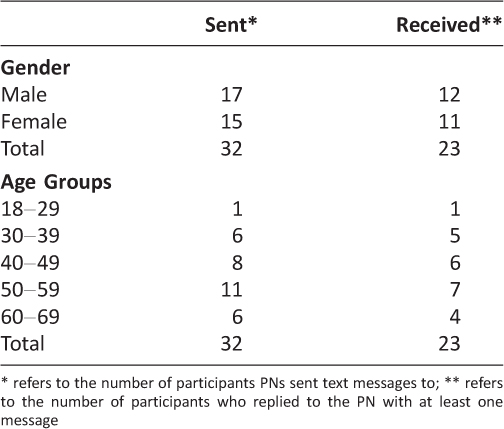
Table 1: Demographic Characteristics and Text messages sent and received during the three month intervention period
Subject interactions through text messaging
During the three months of intervention, 166 messages were sent to a total of 32 participants. In response, 23 participants (72%) responded with a total of 133 text messages, averaging 5.8 messages per texting respondent. Figure 1 shows the details on the frequency of these messages. Each of the 32 participants received at least one message sent by the assigned PN at the beginning of the three-month period. The HBV-infected subjects received a message reminding them to visit a physician for additional tests, and the non-immune participants received reminder messages advising them to get vaccinated. The number of the messages sent by the participants to the PN, however, varied widely, ranging from 0 (among those relying solely on telephone) to more than 10 messages per respondent. Of note, the number of the messages in CHB group was significantly greater than the number of messages in non-immune group. Forty and 126 messages were sent and 26 and 107 test messages were received by the PN in non-immune and CHB groups, respectively. Thus, the average number of messages per texting respondent in the CHB group was 6.7 as compared to 1.6 in the non-immune group.
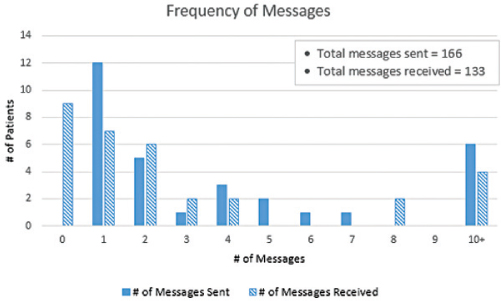
Figure 1: Number of messages sent and received by PN during the three month intervention period
Contents of the messages
We categorized the contents of the messages into the following four broad classes: finding doctors and reminders; health education; compliance/adherence; and other. As shown in figure 2, the greatest proportion of the messages was related to finding doctors and reminders. The majority of these messages belonged to the subjects in CHB group. The second most frequent theme was health education. Participants often asked about the benefits and potential side effects of vaccination, long-term complications of CHB, and use of antiviral medications.
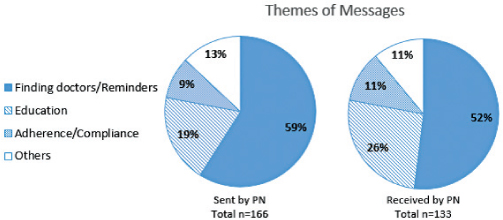
Figure 2: Messages categorized under different themes
Outcome Evaluation
At the end of the three-month study period, 30 participants altogether were linked to a physician or a health care facility for evaluation and vaccination, respectively. This represents a 94% linkage rate.
All of the participants from the non-immune group received at least one vaccination. In the HBV infected group of 16, a total of 14 went to see specialists within the community for further evaluation, demonstrating a linkage rate of 88%. Four of these 14 HBV infected individuals were started on antiviral medication during the three-month intervention period.
Acceptance of Text Messaging
Of 23 individuals who responded with texting, twenty subjects participated in the survey. There were 11 men and 9 women with an average age of 49. As shown in table 2, sixteen respondents preferred texting to phone calls, and 19 respondents expressed satisfaction with texting.
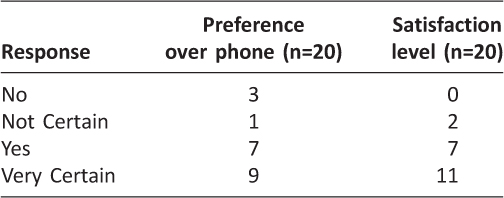
Table 2: Text messaging: Preference over the phone and the level of satisfaction
In the survey addressing specific needs and uses text messaging can serve, a majority of the respondents reported that text messaging provided easy access and saved time, and was useful for finding doctors and for appointment reminders (Table 3). Many also felt texting provided the additional advantage of storing the communication record for future reference. No subject indicated any disagreement with the statement that text messaging is useful.
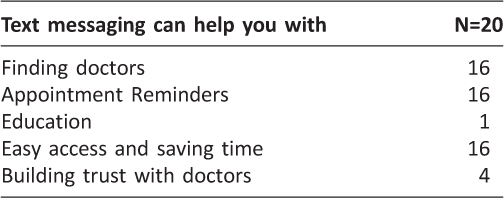
Table 3: Specific uses of text messaging in communication with medical personnel
Discussion
To our knowledge, this is the first study to demonstrate that text messaging can be successfully utilized to enhance patient engagement in hepatitis B care. Text messaging combined with the coordinating role of the PN program not only facilitated communication between the subjects and health care personnel, but it also helped to link the subjects to physicians.
Text messaging- a tool for interactive communication with subjects
Twenty-three of 32 participants actively communicated with PNs through text messaging during the three-month period. Since the remaining nine other participants, who did not reply with texting, responded with phone calls, mobile communication took place with all of the 32 subjects enrolled in the study. Thirty of 32 participants were linked to medical care, demonstrating a 94% linkage rate within a relatively short period: the three-month intervention. Especially in an era when irrational resistance to vaccination has become a serious public health problem, it is also remarkable to see that all 16 individuals in the non-immune group received hepatitis B vaccine, resulting in 100% linkage to care. In the CHB group, 14 out of 16 subjects were linked to physicians, representing a linkage rate of 88%.
The observed impressive rate of response and the high rate of LTC may be attributable to interactive communications between the subjects and the PN. During the first encounter between each subject and the PN, when the intervention began, the PN assessed each individual’s needs and characteristics. The text messages and the contents of the phone calls were subsequently tailored to fit each subject’s needs. A major benefit of mobile technology is its capacity for interactivity, which enables adapting messages according to a subject’s education, socio-economic background, needs, and other characteristics. It can facilitate interpersonal interactions between patients and health professionals. The use of individually tailored information has been shown to be effective in promoting beneficial health behavior changes in adults in other contexts as well.29,30,31
Although text messaging has been the most popular tool for facilitating behavioral interventions towards effective chronic disease self-care support, only a small percentage of American adults living with chronic diseases receives the benefits of text messaging for their health care support.32,33,34 With advances in mobile health services and the widespread use of mobile phones in the Asian American population and in other ethnic minority populations, text messaging may be a powerful, cost-effective way to facilitate communication between the patients and health care personnel, thereby improving health literacy and care disparity in ethnic minority populations.
Role of the Patient Navigator in Linkage
The success of linkage in this study would not have been possible without the PN program. The PN offered a culturally and linguistically tailored navigator program in coordinating access to clinical care by providing the subjects with the available healthcare resources in the community. The PN initially assessed each subject to determine his or her background and needs, and subsequently communicated with the subjects to direct them to meet those needs. The PN system, reliant upon mid-level providers, is thus a healthcare service delivery model built around the patient, created to reduce barriers to care at comparatively modest cost.
The implementation of the PN system is especially helpful in hepatitis B care where LTC has been documented to be poor in various ethnic populations with high prevalence of CHB. Many patients chronically infected with HBV have been unable to access appropriate care for further evaluation and management. For instance, investigators have noted that only 40–66% of HBV infected patients are referred to appropriate care. Further, a large proportion of HBV-infected individuals do not follow up for further evaluation, suggesting a significant failure in sustaining LTC.35,36 Implementation of the PN program, however, has been shown to improve the linkage in CHB. We have previously demonstrated that, within one year, 42 of 45 individuals chronically infected with HBV were linked by a PN program to specialists for appropriate care.37 The high linkage rate of 88% from the CHB group in the current study also supports the critical role of the PN program in facilitating the linkage.
The successful LTC for CHB patients required significantly greater navigational effort than the LTC for the non-immune group. This is reflected in our data, which demonstrated that the number and frequency of messages per texting respondent in the CHB group was 6.7 as compared to only 1.6 in the non-immune group. These results indicate the value of continuous communication between patients and PNs to motivate patients to obtain further care.
Diversity of Message Themes
As shown in the varied contents of the messages, text messaging can convey a wide spectrum of information. Because of its interactive nature, text messaging caters to specific needs of individual patients. In this study, the most frequent theme of the messages was related to finding doctors and appointment reminders. In the CHB group, for instance, a large number of text messages inquired about locating Korean-speaking specialists within their community. Secondly, a substantial number of communications fell under ‘education’. The discussions related to potential use of antiviral medications in CHB and the need for vaccination in non-immune group, for instance, belonged to this category.
The survey from the text message users demonstrated a high degree of satisfaction with text messaging for communicating with the PN (Table 2). A majority of respondents also felt that text messaging allowed easy access, saved time, and helped with finding doctors and remembering appointments (Table 3). These results are congruent with the results of other studies on chronically ill patients, which have demonstrated high levels of receptivity and satisfaction.29,30
Limitations of the study
We recognize that there are some limitations in our study. First, the sample size (n=32) is small, and the participants in this study may not be representative of the overall Korean American or other ethnic minority populations in the United States. Future studies investigating a larger number of subjects with a wider spectrum of ages and socio-economic classes would help to determine the need for and the efficacy of text messaging in engaging patients to obtain care. Secondly, further research is needed to determine if and how interactive communications through text messaging may actually serve to bring about changes in the patient’s health beliefs, which subsequently drive patients towards proper care. Third, studies with a longer intervention period would be required to assess more accurately the safety, sustainability, and effectiveness of text messaging intervention in promoting LTC. Fourth, the current study did not employ a control group receiving usual care without PN-facilitated text messaging, thus limiting a direct comparison between the PN-facilitated text messaging and control group. Nevertheless, the high rate of LTC noted in the current study with PN-facilitated text messaging intervention significantly contrasts with the lack of LTC documented in other previous studies without the use of text messaging.7,8,9,35,36 Fifth, although none of the subjects lost his phone or complained about privacy, reliance on electronic communications entails inherent risks to privacy and security. Where HIPAA or analogous state statutes are applicable, and perhaps even where they are not, measures must be taken to protect privacy and security of text messages, which are often not encrypted and which may be stored by the telecommunication vendor or wireless carrier. Finally, given the critical role played by the PNs in the care of the study subjects, it is not possible to distinguish between the benefits arising from the utilization of text messaging and those attributable to the advice, skill, and culturally competent overall care of the PNs.
Conclusion
Mobile phone text message intervention in hepatitis B care may facilitate communication between patients and medical personnel, thereby helping patients to engage and access appropriate health care services within the community.
Declaration of Conflicting Interests
The authors declare they have no conflict of interest.
Ethics
All procedures performed in studies involving human participants were in accordance with the ethical standards of the institutional and/or national research committee.
Competing Interests
The authors declare that they have no competing interests.
Authors’ Contributions
CSH conceived of the study, participated in the design of the study, and drafted the manuscript. SSK, SL and SY participated in the design of the study and performed statistical analysis. JM participated in its coordination and edited the manuscript. All authors read and approved the final manuscript.
Acknowledgements
This study was supported in part by a grant from Gilead Foundation. The authors acknowledge the work by members and volunteers of the Center for Viral Hepatitis and the Korean Community Services.
References
1. McMahon BJ. Natural history of chronic hepatitis B. Clinics in Liver Disease. 2010;14(3):381–96. ![]()
2. Hollinger FB, Liang TJ. Hepatitis B. Virus. In: Knipe, D.M. et al., eds. Fields Virology, 4th ed. Philadelphia, PA: Lippincott Williams & Wilkins; 2001.
3. Lok AS, McMahon BJ. Chronic hepatitis B: Update 2009 AASLD Practice Guideline. Hepatology. 2009;50(3):661–2. ![]()
4. Cohen C, Holmberg S, McMahon BJ, Block JM, Brosgart CL, Gish RG, London WT, Block, TM. Is chronic hepatitis B being undertreated in the United States? Journal of Viral Hepatitis. 2011;8(6):377–83. ![]()
5. Chang ET, So SK. Ten Largest Racial and Ethnic Health Disparities in the United States based on Healthy People 2010.
6. Hutton DW, Tan D, So SK, Brandeau ML. Cost – effectiveness of Screening and Vaccinating Asian and Pacific Islander Adults for Hepatitis B. Annals Internal Medicine. 2007;147(7):460–9. ![]()
7. Hu KQ, Pan CQ, Goodwin D. Barriers to Screening for Hepatitis B Virus Infection in Asian Americans. Digestive Disease Sciences. 2011;56:3163–71. ![]()
8. Upadhyaya N, Chang R, Davis C, Conti MC, Salinas Garcia D, Tang H. Chronic hepatitis B: perceptions in Asian American communities and diagnosis and management practices among primary care physicians. Postgraduate Medicine. 2010;122(5):165–75. ![]()
9. Philbin MM, Erby LA, Lee S, Juon HS. Hepatitis B and Liver Cancer Among Three Asian American Sub-Groups: A Focus Group Inquiry. Journal of Immigrant and Minority Health. 2012;14(5):858–68. ![]()
10. Gibbons MC. Use of health information technology among racial and ethnic underserved communities. Perspect Health Inf Manag. 2011 Winter.
11. Challenor R, Geegen S. What service users want: a new clinic results service. Can we satisfy both patients’ needs and wants? Int J STS AIDS. 2009;20(10):701–3. ![]()
12. Krishna S, Boren SA, Balas EA. Healthcare via cell phones: a systematic review. Telemed & e Health. 2009;15(3):231–40. ![]()
13. The Association for the Clinicians for the Underserved. Bridging the Disparities Gap with Mobile Technology June 12, 2012. Available at http://clinicians.org/bridging-the-disparities-gap-with-mobile-technology-2/ (Accessed May 4, 2016).
14. Pew Research Center. Mobile Technology Fact Sheet. at http://www.pewinternet.org/fact-sheets/mobile-technology-fact-sheet/ (Accessed May 3, 2016).
15. Perrin A. English-speaking Asian Americans stand out for their technology use. http://www.pewresearch.org/fact-tank/2016/02/18/english-speaking-asian-americans-stand-out-for-their-technology-use/ (Accessed April 20, 2016).
16. Pew Research Center. Internet, Science and Technology. US Smartphone use in 2015. Available at http://www.pewinternet.org/2015/04/01/us-smartphone-use-in-2015/ (last accessed May 4, 2016).
17. Cohen CE, Coyne KM, Mandalia S, Waters AM, Sullivan AK. Time to use text reminders in genitourinary medicine clinics. Int J STD AIDS. Jan 2008;19(1):12–3.
18. Leong KC, Chen WS, Leong KW, Mastura I, Mimi O, Sheikh MA, Zailinawati AH, Ng CJ, Phua KL, Teng CL. The use of text messaging to improve attendance in primary care: a randomized controlled trial. Fam Pract. 2006 Dec;23(6):699–705. Epub 2006 Aug 17.
19. Franklin VL, Greene A, Waller A, Greene SA, Pagliari C. Patients’ engagement with “sweet talk”-a text messaging support system for young people with diabetes. J Med Internet Research 2008;10(2):e20.
20. Gatwood J, Balkrishnan R, Erickson SR, An LC, Piette JD, Farris KB. Mobile phone use and perspectives on tailored texting in adults in Diabetes. JMTM 2015;4(3):2–12. ![]()
21. Horvath T, Azman H, Kennedy GE, Rutherford GW. Mobile phone text messaging for promoting adherence to antiretroviral therapy in patients with HIV infection. Cochrane Database Syst Rev. 2012;3:CD009756.
22. Arya M, Kallen MA, Street RL, Jr., Viswanath K, Giordano TP. African American Patients’ Preferences for a Health Center Campaign Promoting HIV Testing: An Exploratory Study and Future Directions. Journal of the International Association of Providers of AIDS Care 2014.
23. Dowshen N, Kuhns LM, Johnson A, Holoyda BJ, Garofalo R. Improving adherence to antiretroviral therapy for youth living with HIV/AIDS: a pilot study using personalized, interactive, daily text message reminders. J Med Internet Res. 14(2):e51.
24. Stockwell MS, Kharbanda EO, Martinez RA, Vargas CY, Vawdrey DK, Camargo S. Effect of a text messaging intervention on influenza vaccination in an urban, low-income pediatric and adolescent population: a randomized controlled trial. JAMA. 2012 Apr 25;307(16):1702–8. ![]() .
.
25. Evans WD, Abroms LC, Poropatich R, Nielsen PE, Wallace JL. Mobile health evaluation methods: the Text4baby case study. J Health Commun. 17(Suppl 1):22–9.
26. Free C, Knight R, Robertson S, Whittaker R, Edwards P, Zhou W, Rodgers A, Cairns J, Kenward MG, Roberts I. Smoking cessation support delivered via mobile phone text messaging (txt2stop): a single-blind, randomised trial. Lancet 2011;378:49–55. ![]()
27. Patrick K, Raab F, Adams MA, Dillon L, Zabinski M, Rock CL, Griswold WG, Norman GJ. A text message-based intervention for weight loss: randomized controlled trial. Journal of medical Internet research 2009;11:e1.
28. van der Kop ML, Memetovic J, Patel A, Marra F, Sadatsafavi M, Hajek J, Smillie K, Thabane L, Taylor D, Johnston J, Lester RT. The effect of weekly text-message communication on treatment completion among patients with latent tuberculosis infection: study protocol for a randomised controlled trial (WelTel LTBI). BMJ Open 2014;4:e004362.
29. Gatwood J, Balkrishnan R, Erickson SR, An LC, Piette JD Farris KB. Addressing medication nonadherence by mobile phone: Development and delivery of tailored messages. Res Social Adm Pharm 2014;10(6):809–23. ![]()
30. Gatwood J, Balkrishnan R, Erickson SR, An LC, Piette JD, Farris KB. Mobile phone use and perspectives on tailored texting in adults with diabetes. J mobile Tech in Medicine. 2015;4(3):2–12. ![]()
31. Lewis MA, Uhrig JD, Bann CM, Harris JL, Furberg RD, Coomes C, Kuhns LM. Tailored text messaging intervention for HIV adherence: a proof-of-concept study. Health Psychol. 2013 Mar;32(3):248–53.
32. Cole-Lewis H, Kershaw T. Text messaging as a tool for behavior change in disease prevention and management. Epidemiol Rev 2010 Apr;32(1):56–69.
33. Pew Research Center Mobile Health 2012 Available at: http://www.pewinternet.org/Reports/2012/Mobile-Health.aspx (Accessed May 1, 2016).
34. Free C, Phillips G, Galli L, Watson L, Felix L, Edwards P, Patel V, Haines A. The effectiveness of mobile-health technology-based health behavior change or disease management interventions for health care consumers: a systematic review. PLoS medicine 2013;10:e1001362.
35. Pollack H, Wan K, Miyoshi T, et al. Management of chronic hepatitis B virus (HBV) infection by primary care physicians in urban hospitals and clinics in New York City. [abstract 984]. Hepatology. 2007;46(Suppl):676A.
36. Nishimura A, Shiono P, Stier, D. Enhanced Surveillance for Chronic Hepatitis B-San Francisco, [abstr OP-57]. Presented at the 13th International Symposium on Viral Hepatitis and Liver Disease, Washington, DC, March 22, 2009.
37. Hyun CS, Ventura WR, Kim SS, Yoon S, Lee S. A Community- based Hepatitis B Linkage-to-Care Program: A Case Study on Asian Americans chronically infected with Hepatitis B virus Hepatology, Medicine and Policy. 2016;1:6.

